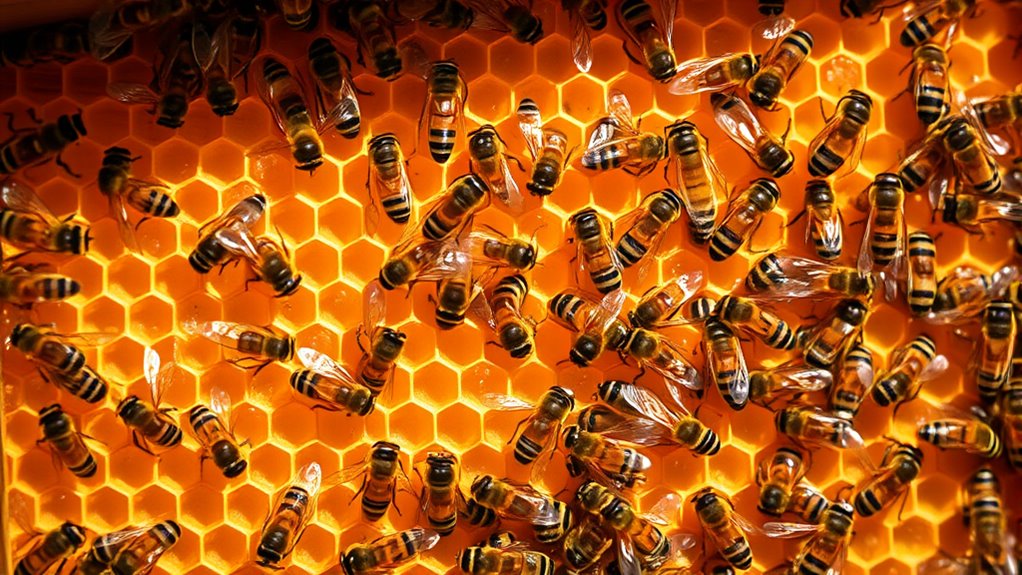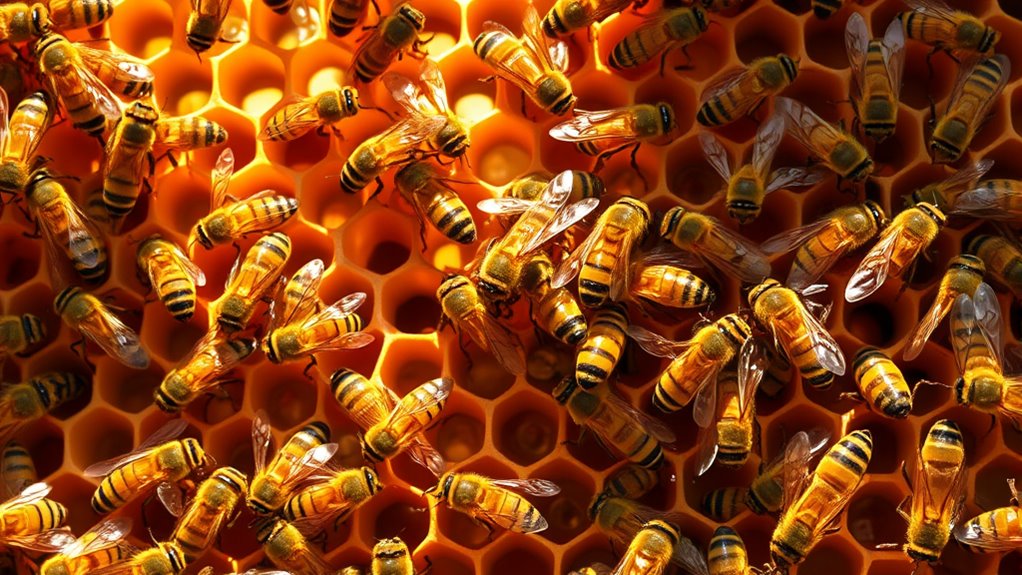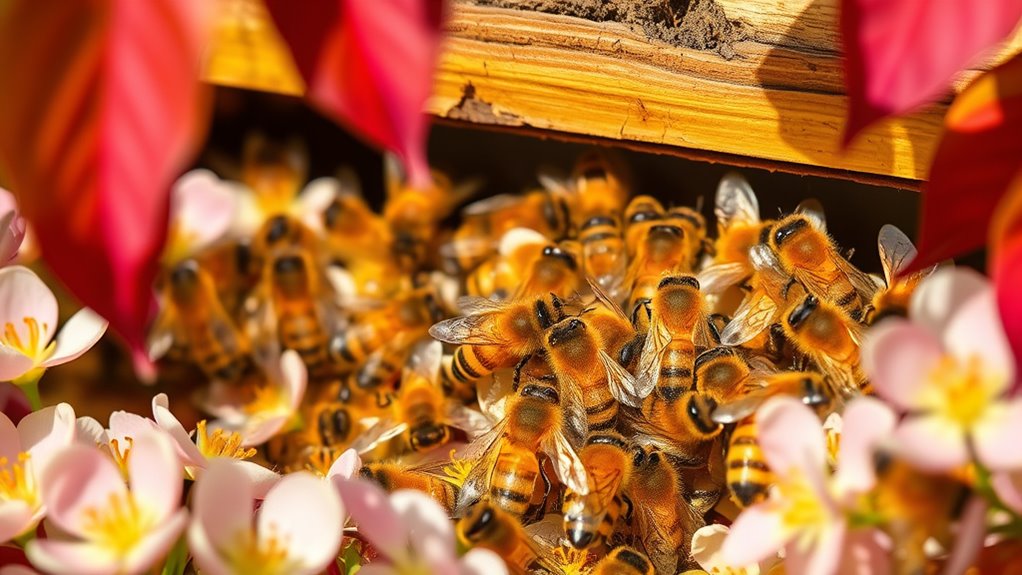In a honeybee colony, you'll find a structured society made up of three castes: the queen, worker bees, and drones. The queen lays eggs and releases pheromones, while workers handle foraging and care for larvae. Drones' main role is mating with the queen. As seasons change, the colony shifts its focus from building its workforce in spring to resource gathering in summer, and finally preparing for winter. Discover more about their fascinating lives and teamwork within the hive.
Key Takeaways
- A honeybee colony consists of a queen, worker bees, and drones, each with specific roles for colony success.
- The queen lays up to 1,500 eggs daily, determining the colony's future makeup through fertilized and unfertilized eggs.
- Worker bees perform various tasks including foraging, cleaning, and caring for larvae, showcasing a division of labor.
- Seasonal changes influence colony activities, with spring focusing on workforce building and fall preparing for winter resource conservation.
- Communication through pheromones and the waggle dance is essential for cooperation and efficient resource gathering within the hive.
The Structure of a Honeybee Colony

A honeybee colony is a remarkable example of social organization, consisting of three distinct castes: the queen, worker bees, and drones.
At the heart of the colony, the queen is the sole reproductive female, laying up to 1,500 eggs daily.
The worker bees, the most numerous adults, perform various roles throughout their lives. From foraging for nectar to cleaning the hive, each worker honey bee contributes to the entire colony's success. They also care for the queen and her larvae, ensuring a healthy population.
Drones, on the other hand, focus solely on mating with the queen.
This intricate structure and division of labor highlight the essential roles each caste plays in maintaining a thriving honey bee colony.
The Roles of the Queen, Workers, and Drones

Understanding the structure of a honeybee colony sets the stage for exploring the specific roles each caste plays.
The queen is the colony's heart, laying up to 1,500 eggs daily and producing pheromones that keep the hive cohesive.
Worker bees, all female, take on various tasks throughout their short lives, from cleaning and feeding larvae to foraging for honey and maintaining the hive.
Drones, the males, exist solely to mate with the queen; they don't help with hive maintenance and usually die shortly after mating or are expelled when resources run low.
The queen's ability to determine the colony's makeup through fertilized and unfertilized eggs is vital for maintaining a healthy, efficient hive throughout its life cycle.
The Lifecycle of Honeybees

As honeybees develop, they pass through three distinct stages: egg, larva, and pupa, each playing an essential role in determining the colony's future.
The queen lays eggs that hatch into larvae within three days. Depending on their diet, larvae become queens, workers, or drones; for instance, queens are fed royal jelly, ensuring their development.
The queen's diet determines the fate of larvae, shaping future queens, workers, or drones essential to the colony.
The larval stage lasts about 5.5 days for queens, 6 days for workers, and 6.5 days for drones. After that, pupation occurs, with varying capping times for each caste.
From egg to adult, queens take 16 days, workers 21 days, and drones 24 days. Adult honey bees emerge by chewing their way out, ready to fulfill their roles in honey bee life.
Seasonal Changes and Their Impact on the Colony

Seasonal changes profoundly influence the dynamics of a honeybee colony, shaping its behavior and survival strategies throughout the year.
In spring, you'll notice the bees focus on building their workforce, preparing for the essential resource collection from blooming flowers.
By summer, the hive reaches its peak activity, with worker bees foraging tirelessly for nectar and pollen to fuel growth and honey production.
As fall approaches, the resource collection slows due to cooler temperatures and fewer flowers, prompting preparations to survive the winter. During this phase, the old queen is surrounded by worker bees that cluster together for warmth.
In winter, they rely solely on stored honey, with some worker bees living up to six months to guarantee the colony thrives until spring.
Communication and Cooperation Within the Hive

The survival of a honeybee colony hinges not just on the changing seasons, but also on the intricate communication and cooperation among its members.
The survival of a honeybee colony relies on both seasonal changes and the vital teamwork among its members.
Here's how they work together:
- Pheromones: The queen releases pheromones to signal her presence and reproductive status, guaranteeing colony cohesion.
- Waggle Dance: Forager bees perform the waggle dance, indicating the direction and distance to food sources, effectively guiding others.
- Worker Bees: These bees shift from hive maintenance to foraging as they age, showcasing their cooperative spirit.
Effective communication and cooperation are essential for the colony's success, especially in resource gathering during peak summer activity.
Frequently Asked Questions
What Is the Life Cycle of a Honey Bee Colony?
The life cycle of a honey bee colony starts in spring when the queen lays about 2,000 eggs daily.
These eggs develop into larvae and then pupae, with queens maturing in 16 days, workers in 21, and drones in 24.
As workers emerge, they take on roles inside the hive, later evolving to foraging.
The colony thrives in summer, slows in fall, and survives winter on stored honey until the cycle restarts in spring.
What Is the 7/10 Rule in Beekeeping?
Think of your hive as a bustling city—if 70% of the frames are buzzing with bees and brood, you've got a thriving community.
That's the essence of the 7/10 Rule in beekeeping. It helps you gauge your colony's health and productivity.
When you see that occupancy, you know it's time to add more supers or resources, keeping your bees happy and preventing overcrowding for a smoother honey production season.
How Long Do Honey Bee Colonies Last?
Honey bee colonies can last several years, depending on various factors.
The queen typically lives two to three years, though some can reach up to five.
Worker bees usually have a short lifespan of about six weeks during the productive season, but those born in fall can live up to six months.
Drones, on the other hand, last around five to seven weeks.
The overall health and environment greatly influence the colony's longevity.
What Is the Hierarchy of a Bee Colony?
Imagine a kingdom where the queen reigns supreme, orchestrating her loyal subjects.
In this buzzing domain, you've got three distinct roles: the queen, who lays thousands of eggs; the diligent workers, nurturing the young and gathering food; and the drones, the royal suitors, whose purpose is to mate.
Each bee plays its part in maintaining harmony, with the queen's pheromones guiding the workers, securing the colony's survival in this intricate social structure.
Conclusion
In the intricate world of a honeybee colony, every member plays a crucial role, much like the notes in a harmonious symphony. Understanding their structure, roles, and lifecycle highlights the beauty of cooperation and communication within the hive. As seasons change, so do the challenges they face, yet their resilience shines through. By appreciating these remarkable creatures, you not only deepen your connection to nature but also contribute to the preservation of their indispensable work in our ecosystem.










